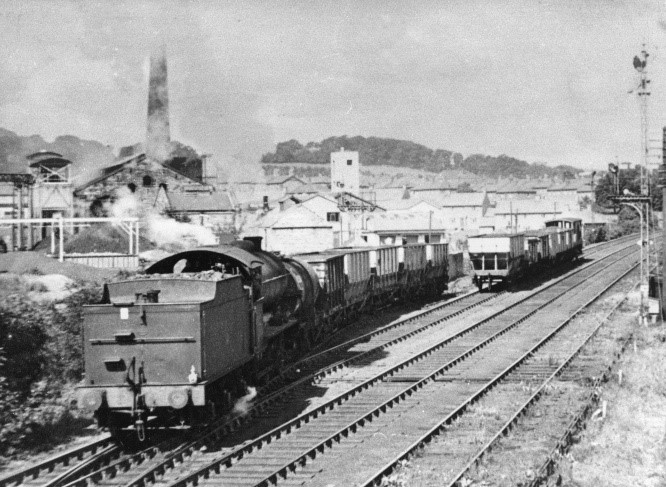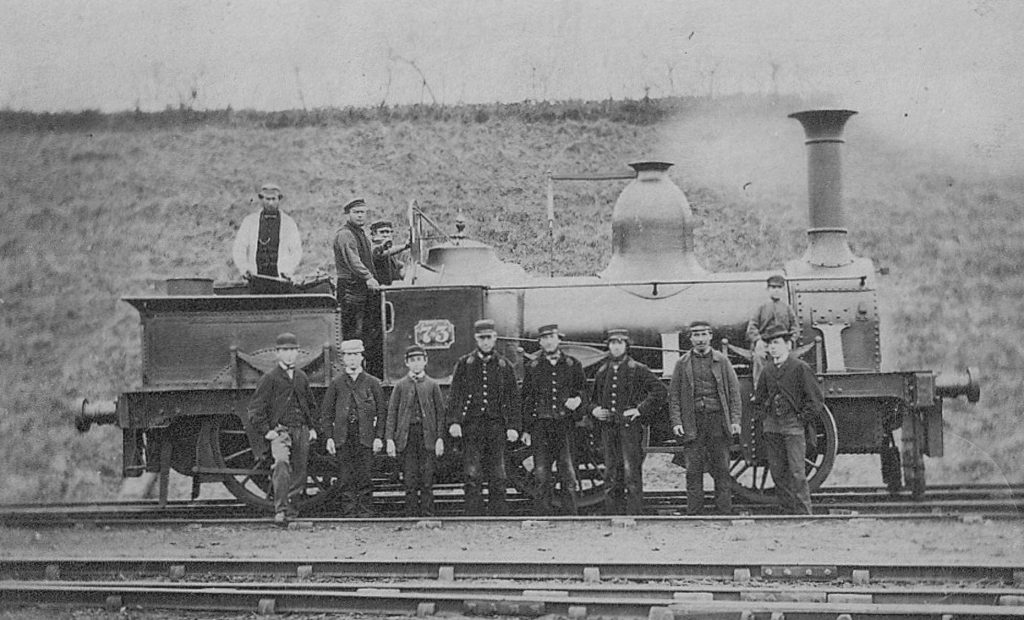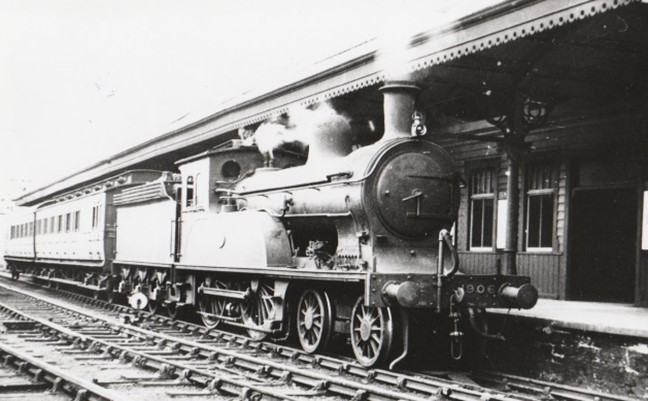The Royal Assent was given to the Act of Parliament authorising the Northumberland and Berwick Railway on 31st July 1845. This had been backed by George Hudson with the engineering support of George Stephenson. An alternative scheme, the Northumberland Railway (which had the backing of Lord Howick) came to naught. The first section, between Heaton, Newcastle, and Morpeth was opened to traffic on 1st March 1847 and on 1st July 1847 trains were running between Newcastle (Carlisle Square station) and Tweedmouth. Only on the completion of the bridges across the Tyne and Tweed could a ‘through’ service of trains proceed between Scotland and stations south of Newcastle. In the vicinity of Alnwick the Newcastle and Berwick line ran close to the coast. There were two reasons for this: firstly the Duke of Northumberland was not at all enthusiastic about the line crossing his estates and secondly the more ‘direct route’, closer to Alnwick, would have been more expensive to construct involving the crossing of various hills and valleys, necessitating the construction of bridges or viaducts and substantial gradients. The Duke offered less resistance to the construction of a branch line linking the main line with the town. The branch was constructed by the contractors Rush and Lawson and opened to freight traffic on 5th August 1850. Passenger traffic started two weeks later.


Here are two views of Alnmouth station (formerly Bilton) taken around the year 1900. The first shows a view, looking north, from one of the main line platforms. Note the magnificent signal gantry (including signals for the Alnwick branch trains on the left) and the signalbox on the right. The Alnwick trains normally used a platform a few yards to the left of the photographer. The right hand view shows the up platform with passengers (and their luggage) awaiting a southbound train. Note the steps and footbridge linking the platforms and the luggage trolley.
From the junction station at Bilton (later Alnmouth) the line ran northwards paralleling the main line for about three quarters of a mile before turning north-westwards towards Alnwick. The major engineering feature was the Cawledge Viaduct (404’ in length) crossing the Cawledge Burn. This was built with seven arches in the style of the viaduct over the River Aln on the main line. Each arch had a span of 45’ and was about 53’ above the burn at its highest point. There were several bridges over the line, including some for field access, also some culverts under the line. Before reaching Alnwick there were several sidings, serving the gasworks and an oil terminal. Just before the terminus there was a substantial bridge over the A1 road and a road overbridge at the station’s throat.


These two mid-twentieth century pictures show the sidings on the approach to Alnwick. On the left a Class K1 locomotive shunts the sidings of Alnwick Gasworks whilst the right hand photograph shows the siding which was used as an oil terminal and was especially important during World War 2 for supplying fuel to nearby aerodromes.

The original Alnwick station was a simple affair. It had a single platform with a stone building which included a waiting room and station offices. A goods yard and warehouse were nearby.

Initially there were four passenger trains running in each direction but by 1863 this had increased to eleven each way! The station facilities were seen to be inadequate when the line to Cornhill was proposed and a new, much grander, station was opened on 5th September 1887 to coincide with the opening of the line to Cornhill. It had two platforms and a magnificent overall roof with booking office, and offices for the station master and for handling parcels. The platform buildings included a general waiting room, two ladies waiting rooms, toilets, and, a few years later, a refreshment room. At the same time the goods yard and facilities were improved, as were the signaling arrangements.


Here are two views of the ‘new’ Alnwick station and goods yard. The first, taken soon after the new station opened, shows the top-hatted station master posing in front of the station’s goods staff, whilst the second shows the platforms decked out with ‘finery’ for a royal visit; the royal train is in the background. The print bears the year: 1908 and illustrates the visit of the future King George VIth and Queen Mary. Two years earlier the then-current King, Edward VIIth had arrived at Alnwick Station to stay at Alnwick Castle.


As this Bradshaw’s Guide shows, there were no intermediate stations on the branch. On weekdays in July 1922 there were 14 trains from Alnwick to Alnmouth with one extra in the reverse direction. The Sunday service consisted of eight trains each way. Most of the trains shuttled between these two stations though in the mornings and evenings there were some through trains between Alnwick and Newcastle which ran as fast trains between Alnmouth and Newcastle; these were ‘commuter’ trains in modern parlance! In 1932 these trains consisted of five well-loaded carriages! Some trains from Alnwick were scheduled to reverse at Alnmouth with the train heading north to Berwick.


These two photographs show early 20th century trains on the branch. Both show typical two-coach trains. The first was taken in the branch platform at Alnmouth station whilst the second shows what is possibly a Cornhill line train entering Alnwick station, passing the tall station signal box. This allowed the signalman to observe train beyond the road bridge in the background.


In the 1960s the K1 2-6-0 engines, based at Alnmouth shed, provided the motive power for the steam hauled passenger trains. Here a K1 is ready to depart from Alnmouth with a train for Alnmouth. Just before the line’s closure the branch was dieselised. Two-car multiple unit trains took over the Alnwick to Alnmouth trains, plus the through commuter trains to and from Newcastle. Here one departs from Alnwick station. This unit is displaying ‘Newcastle’ on its destination screen.
Alnwick was a popular destination for tourist trains from Newcastle and the platform of the original station platform (known until 1908 as the ‘excursion platform’) was often pressed into service to accommodate these trains. Occasionally ‘main line’ engines would haul these trains. In the early 1960s special trains for the York Women’s’ Institute ran into Alnwick behind large Pacific locomotives. A fleet of road coaches awaited their arrival and whisked them off to popular local destinations including Bamburgh Castle!

There was a variety of goods traffic on the line. Outward traffic included stone and grain plus many wagons carrying livestock including cattle arriving from Ireland. Cheviot sheep were brought in from farms to Alnwick and transported onwards by rail. Coal arrived by rail for the gasworks and for domestic use, also fuel oil for the sidings a short distance long the branch. In World War 1 much timber, emanating from Whittingham on the Cornhill branch, passed through Alnwick, taking for example, pit props to the south Northumberland collieries. On at least one occasion a train successfully delivered a circus, including its animals, to Alnwick!



Towards the end of the line’s existence the branch had some unusual visitors! In the left hand photograph is a 2-6-2 Class V2 locomotive hauling the branch train deputising for a failed K1 engine. On the right, shown hauling a passenger train at Alnmouth is a large Deltic diesel locomotive. Whist none of this type arrived at Alnwick on a passenger train, one member arrived at Alnwick hauling the Heaton (Newcastle) breakdown train following a derailment in the station.
Several cartage and delivery vehicles operated out of Alnwick delivering and collecting parcels, bicycles, newspapers and agricultural implements to and from the farms, businesses and private houses in the local area.
The branch, for most of its existence, was double-tracked until shortly before closure. On 14th February 1965, it was announced that the branch would become just a single track. The signalling was originally by means of semaphore signals operated from several signalboxes at Alnwick and the signalbox at Bilton, later Alnmouth. Shortly before the line closed the semaphore signals were replaced by colour light signals and the branch signalboxes were closed!
Despite the doubling of ticket sales between 1951 and 1967 the branch did not escape the 1960s cutbacks in the nation’s rail system. On 28th September 1967 the Transport Minister gave consent to closure. The line closed from 23rd January 1968 for passenger traffic, though the goods service lingered on until 7th October. Soon after closure the track was lifted by a contractor and the trackbed and foundation was cut to the east of the town to permit the construction of the A1 Alnwick by-pass road. This, of course, eliminated the need for an expensive new rail bridge over the new road!
The photographs illustrating this item are mainly from the Aln Valley Railway’s photographic archive including some from the Armstrong Railway Photographic Trust. The work of a variety of photographers is shown, including John Mallon, David Appleby and William Stafford.
The full history of the line is described in the book entitled ‘The Alnwick Branch’ written by Bartle Rippon and published by Kestrel Railway Books in 2008.